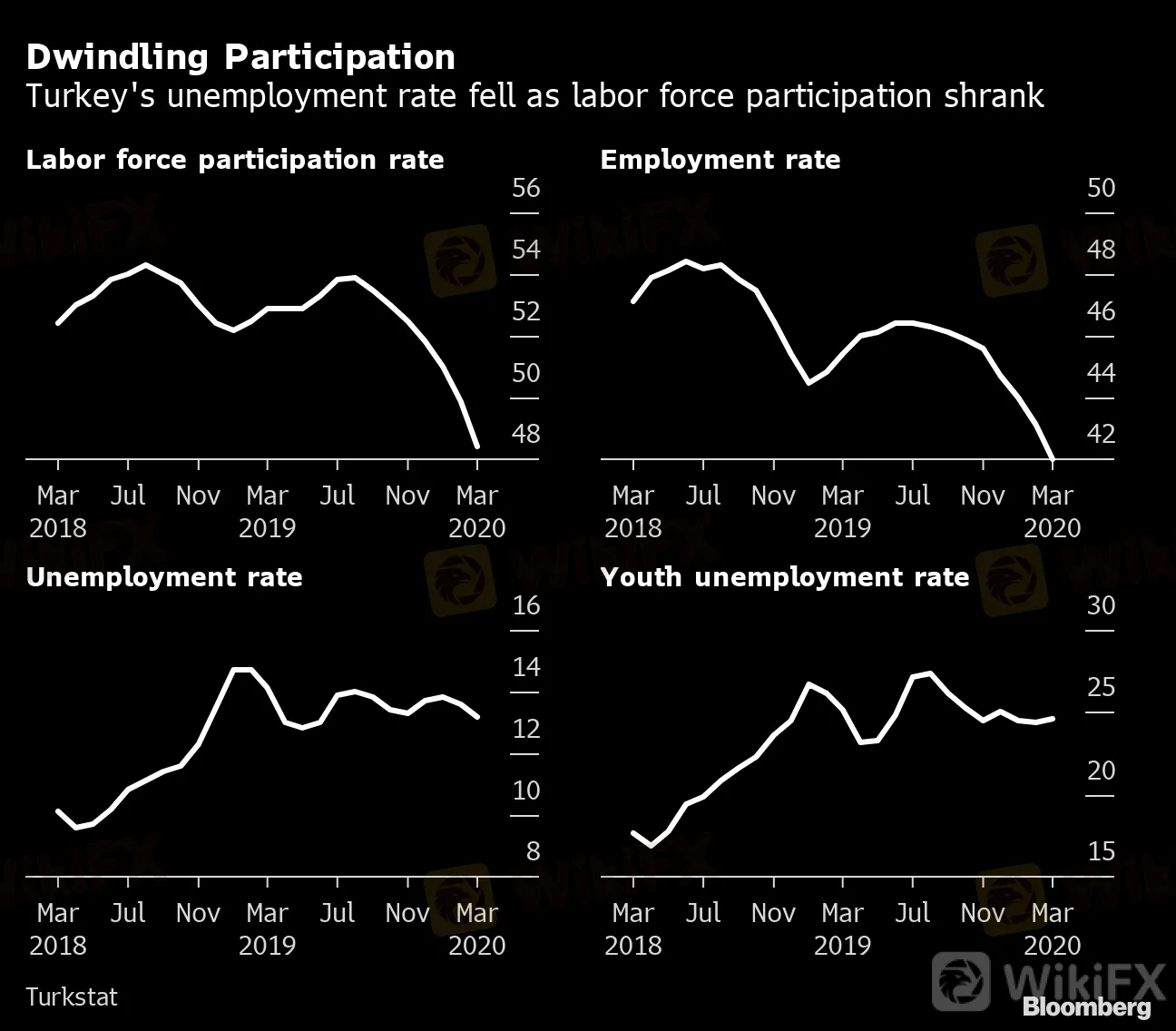简体中文
繁體中文
English
Pусский
日本語
ภาษาไทย
Tiếng Việt
Bahasa Indonesia
Español
हिन्दी
Filippiiniläinen
Français
Deutsch
Português
Türkçe
한국어
العربية
Unemployment Finds Ways to Hide in a Country That Banned Layoffs
Abstract:Look beyond unemployment to get a read on Turkeys labor market.
Look beyond unemployment to get a read on Turkeys labor market.
The government‘s temporary ban on layoffs, coupled with allowances for workers, are helping mask the extent of the distress in an economy tripped up by the coronavirus pandemic. Reported with a lengthy lag, official data show Turkey’s unemployment rate at 13.2% in February-April, a slight drop from the first quarter.
But the numbers of employed and those who depend on cash support from the government tell a different story. Turkeys labor force participation rate -- or the share of the population that has a job or is looking for one -- fell 4.5 percentage points annually to 48.4% in February-April, the least since January 2014. Employment tumbled to its lowest level in over eight years.
Dwindling Participation
Turkey's unemployment rate fell as labor force participation shrank
Turkstat

The government‘s measures only limited employment losses “on paper,” according to a report by Istanbul’s Bahcesehir University Center for Economic and Social Research.
Keeping the jobless count in check is one of the top priorities for President Recep Tayyip Erdogan and his ruling party, which last year lost local elections in most of the municipalities where unemployment was running in double digits -- including the biggest city Istanbul and capital Ankara.
But whereas Europes biggest economies could afford to spend about 100 billion euros ($113 billion) on furlough programs from March to May, Turkey had to strike a more moderate path, since its budget was already under strain after an election spending splurge and a brief recession that followed a currency crisis.
Still, as parts of the economy shut down to contain the contagion, the government banned layoffs for six months from March 10 and offered a 1,177-lira ($172) monthly allowance to those placed on leave by their employees.
‘Short Term’
“The continued drop in the labor force participation rate, government allowances and unpaid leave practices will prevent a sharp increase in the unemployment rate in the short term,” said Haluk Burumcekci, the founder of Istanbul-based independent research firm Burumcekci Research and Consulting.
The result has been to bottle up unemployment. But as it fell, so did the number of working Turks, which dropped by 1.5 million to 26.1 million since the beginning of the year. That added to the labor market‘s loss of 2.4 million employees in the past two years, a period when the nation’s population grew by almost the same number.
Less Workers
The number of employees is falling even as population rises
Turkstat

The headline figures also leave out the millions of people who are effectively out of a job but cant be fired due to the layoff ban. And the costs are now adding up.
As of May, around 3.1 million people were taking advantage of the so-called short-time working allowance program, which gives support payments to employees whose workplaces were partially or fully shut down because of the measures to contain the outbreak. The government spent 10.3 billion liras for the program in April and May alone.
Another 1.4 million Turks who arent eligible for the short-time work program and lost their jobs after March 15 qualify for another cash support initiative. Turkey spent an additional 1.7 billion liras on this program in April and May.
As a result of the layoff ban and stipends, the total assets of Turkeys unemployment fund dropped by almost 9% from 2019 to about 120 billion liras as of June 9.
Virus Impact
Total assets of Turkeys unemployment fund dropped by 9% from 2019
Source: ISKUR
Note: 2020 figure as of June 9

The extent to which revenue losses will lead to payroll cuts in the services sector -- which accounts for 57% of the labor market with 15 million workers -- could determine if Turkey can claw back jobs lost during the pandemic, Burumcekci said.
Turkish manufacturers are already seeing signs of a recovery, taking on additional staff in June after two months of scaling back employment, according to a report compiled by the Istanbul Chamber of Industry and IHS Markit.
Disclaimer:
The views in this article only represent the author's personal views, and do not constitute investment advice on this platform. This platform does not guarantee the accuracy, completeness and timeliness of the information in the article, and will not be liable for any loss caused by the use of or reliance on the information in the article.
WikiFX Broker
Latest News
TradingView Brings Live Market Charts to Telegram Users with New Mini App
Trump tariffs: How will India navigate a world on the brink of a trade war?
Interactive Brokers Launches Forecast Contracts in Canada for Market Predictions
Authorities Alert: MAS Impersonation Scam Hits Singapore
Stocks fall again as Trump tariff jitters continue
INFINOX Partners with Acelerador Racing for Porsche Cup Brazil 2025
Regulatory Failures Lead to $150,000 Fine for Thurston Springer
April Forex Trends: EUR/USD, GBP/USD, USD/JPY, AUD/USD, USD/CAD Insights
March Oil Production Declines: How Is the Market Reacting?
Georgia Man Charged in Danbury Kidnapping and Crypto Extortion Plot
Currency Calculator







